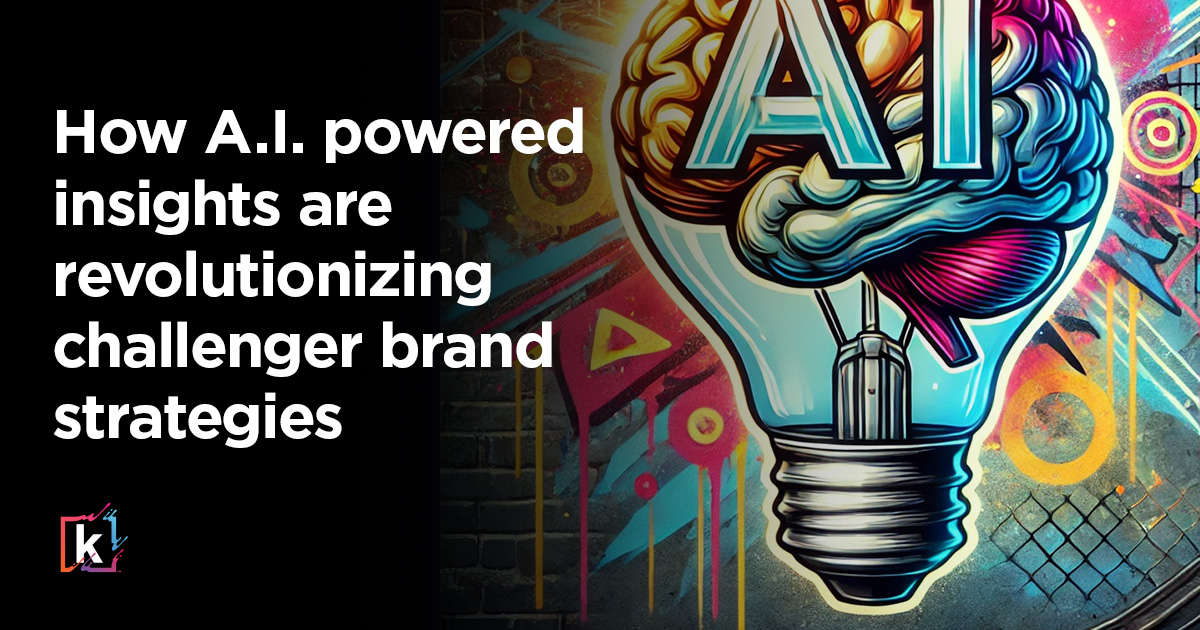How AI-Powered Insights are Revolutionizing Challenger Brand Strategies


One thing is certain: the marketing landscape is constantly evolving. However, challenger brands are increasingly turning to artificial intelligence (AI) to level the playing field against larger, more established competitors. As we move through the rest of 2024 and beyond, AI-powered insights are not just a luxury, but a necessity for brands looking to make a significant impact in their respective markets.
This shift towards more sophisticated data-driven strategies is enabling challenger brands to gain deeper consumer insights, create more personalized campaigns, and optimize their marketing efforts in ways previously unimaginable. By harnessing the power of machine learning and predictive analytics, these brands are not only competing but often outmaneuvering their larger counterparts.
In this blog, we'll explore how AI is revolutionizing challenger brand strategies, examining specific tactics and drawing valuable lessons for marketers navigating this new AI-enhanced landscape.
Enhancing Consumer Segmentation with AI
Understanding the nuances of consumer behavior is crucial for any brand, but for challenger brands, it's especially important. These tools have revolutionized consumer segmentation by enabling brands to analyze vast amounts of data and identify patterns that would be impossible to detect manually. By using AI-driven analytics, challenger brands can create highly specific consumer segments, allowing for more targeted and effective marketing efforts.
Example: Prose Custom Hair Care
Prose, a challenger brand in the hair care industry, uses AI to create highly-personalized hair care products. Their system analyzes more than 85 factors, including customers' hair type, lifestyle, and environment, to create custom formulations.
Marketing Tactic:
Prose leverages this AI-driven personalization in their marketing campaigns. They use social media ads that highlight how their internal platform creates unique formulas for each customer, directly addressing individual hair concerns.
Lessons for Marketers:
- Precision Targeting: Using more personalized data allows for segmentation based on highly specific attributes, enabling more effective targeting.
- Data-Driven Product Development: Data-driven insights can guide the creation of products that meet specific customer needs, increasing the likelihood of success.
- Personalization as a Selling Point: Using AI capabilities is a key differentiator in marketing messages, showcasing the unique value proposition of tailored products.
Personalizing Customer Experiences with AI
Personalization has become a key differentiator in the competitive landscape, and AI is at the forefront of this shift. Challenger brands are using these new innovations to deliver hyper-personalized customer experiences, from tailored product recommendations to personalized marketing messages. This level of personalization not only enhances customer satisfaction but also drives higher engagement and conversion rates.
Example: Stitch Fix
Stitch Fix –an online personal styling service– uses AI to personalize clothing recommendations for each customer. Their algorithm considers style preferences, size, fit, and feedback to suggest items that are highly likely to resonate with individual customers.
Marketing Tactic:
Stitch Fix's "Style Shuffle" game obtains and uses smart data to learn customer preferences. The insights gained are used to create personalized marketing emails featuring clothing items tailored to each customer's style.
Lessons for Marketers:
- Interactive Data Collection: Create engaging ways for customers to provide preference data, which can be used to enhance personalization.
- Continuous Learning: Use AI-related platforms to continuously refine customer profiles based on interactions, ensuring that recommendations remain relevant and appealing.
- Cross-Channel Personalization: Apply AI-driven insights across all customer touchpoints– from email marketing to in-app experiences– to maintain a consistent and personalized brand experience.
Optimizing Marketing Campaigns with AI
AI is transforming the way challenger brands design, execute, and optimize their marketing campaigns. By leveraging these platforms, brands can analyze the performance of campaigns in real-time, adjust strategies on the fly, and even predict future trends to stay ahead of the competition. This level of optimization is crucial for challenger brands that need to maximize the impact of their marketing efforts with limited resources.
Example: Airbnb
While not a traditional challenger brand, Airbnb's innovative use of generative tools in marketing offers valuable lessons for any brand looking to disrupt their industry. Airbnb utilizes this new-age technology to optimize its digital marketing spend across multiple channels, including search, social, and display advertising.
Marketing Tactic:
Airbnb's AI system analyzes user behavior, predicts the likelihood of booking, and adjusts bid strategies in real-time across various platforms. This approach has allowed Airbnb to maximize its return on ad spend (ROAS) while minimizing cost-per-acquisition (CPA).
Lessons for Marketers:
- Dynamic Budget Allocation: Use AI to automatically shift budgets to the best-performing channels, ensuring that resources are used most effectively.
- Predictive Analytics: Leverage AI to anticipate user behavior and optimize campaigns proactively, rather than reacting to results after the fact.
- Cross-Platform Optimization: Implement AI systems that can manage and optimize campaigns across multiple platforms simultaneously, ensuring a cohesive and efficient marketing strategy.
Leveraging AI for Competitive Analysis
For challenger brands, understanding the competitive landscape is crucial. AI tools provide a significant advantage by enabling brands to conduct in-depth competitive analysis, uncovering insights that can inform their strategies. By monitoring competitors' activities, tracking market trends, and analyzing consumer sentiment, said tools help challenger brands identify opportunities to differentiate themselves and capture market share.
Example: Crayon
While not a challenger brand itself, Crayon provides AI-powered competitive intelligence tools that are used by many challenger brands to gain an edge in their industries.
Marketing Tactic:
Challenger brands use Crayon's AI to track competitors' product launches, pricing changes, and marketing campaigns in real-time. This information is then used to quickly adjust their own strategies and messaging, ensuring they remain competitive.
Lessons for Marketers:
- Real-Time Monitoring: Use AI to keep a constant pulse on competitor activities, allowing for swift responses to new developments.
- Opportunity Identification: Leverage AI insights to spot gaps in the market that competitors aren't addressing, providing a chance to differentiate and capture untapped customer segments.
- Rapid Response: Develop systems that allow for quick strategy adjustments based on competitive intelligence, ensuring that your brand stays agile and responsive to market changes.
As challenger brands continue to disrupt established industries, AI-powered insights are proving to be a game-changer. From enhancing consumer segmentation and personalizing customer experiences to optimizing marketing campaigns and conducting competitive analysis, AI is enabling these brands to operate with unprecedented precision and efficiency.
The key lessons for marketers are clear: embrace AI to achieve more precise targeting, deliver personalized experiences at scale, optimize campaigns in real-time, and leverage competitive analysis to stay ahead of the curve.
As we move further into 2024 and beyond, the brands that effectively integrate AI into their strategies will not only survive but thrive in an increasingly competitive marketplace. By leveraging AI-powered insights, challenger brands can level the playing field against larger competitors, creating more meaningful connections with their audiences and driving sustainable growth. As AI technology continues to evolve, staying at the forefront of these developments will be crucial for turning ambitious visions into market-leading realities.

